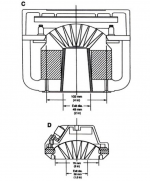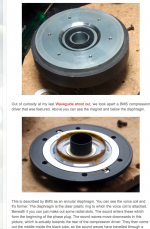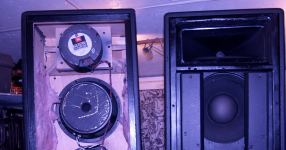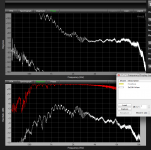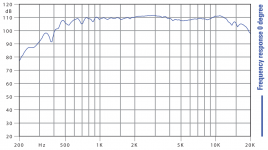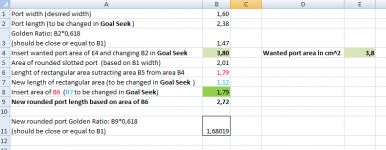Is this maybe a good idea? very nice aproach and the truth about our modern society.
regards kees
The cycle of life...
Most drivers look like "C" or "D" inside, most modern 1" exit like "D" are around 30mm from diaphragm to phase plug exit.Is there any way to approximate the length from the compression driver phase plug to its exit?
Annular ring diaphragms (like BMS uses) are different.
With a bright light you can often see the diaphragm position through the plug.
Attachments
Last edited:
Is there any way to approximate the length from the compression driver phase plug to its exit?
JLH, you have done a dozen (or more) models. I don't suppose you have every driver's specs at hand?
/Thomas
The path length of the BMS 4550 is 6.7cm.
The path length of the BMS 4552 is 5.1cm.
The path length of the Selenium D220ti-omf-8 is 3.65cm
The path length of the RCF N350 is 3.95cm
The path length of the RCF ND350 is 2.25cm
I expect the B&C Speakers DE120 to have a path length around 2.2cm to 2.5cm. I'll measure it when they arrive. All you have to do is remove the diaphragm and slip a piece of paper through the phase plug slits. Measure the distance the paper goes from the top of the phase plug to the exit. Add about a 1mm for the space between the phase plug and diaphragm. This will give you a good enough number to model with. This number will give you the worst case in the model because the acoustical center of the driver actually occurs slightly forward of the diaphragm. To measure the actual acoustical path length you need to do an impulse test and calculate it based on the speed of sound.
The path length of the BMS 4550 is 6.7cm.
The path length of the BMS 4552 is 5.1cm.
The path length of the Selenium D220ti-omf-8 is 3.65cm
The path length of the RCF N350 is 3.95cm
The path length of the RCF ND350 is 2.25cm
I expect the B&C Speakers DE120 to have a path length around 2.2cm to 2.5cm. I'll measure it when they arrive. All you have to do is remove the diaphragm and slip a piece of paper through the phase plug slits. Measure the distance the paper goes from the top of the phase plug to the exit. Add about a 1mm for the space between the phase plug and diaphragm. This will give you a good enough number to model with. This number will give you the worst case in the model because the acoustical center of the driver actually occurs slightly forward of the diaphragm. To measure the actual acoustical path length you need to do an impulse test and calculate it based on the speed of sound.
Thank you, John - for the very thorough explanation!
/Thomas
Flare rate
Guys!
After a lot of thought, and since I'm down the active Synergy route, I've decided to model a 2-way.
I also forgot to say that I'm lazy, so I'm currently working on a SH-95 "clone" (90 x 40) employing the Faital HF-146 and/or Faital PR200/B&C NDL51.
What I don't undestand is: the flare rate that the CD sees, going from 9.93cm^2 (throat) to 18.86 takes 0,99cm, which translates to 1774Hz!
How can this successively be crossed <1000Hz
/Thomas
Guys!
After a lot of thought, and since I'm down the active Synergy route, I've decided to model a 2-way.
I also forgot to say that I'm lazy, so I'm currently working on a SH-95 "clone" (90 x 40) employing the Faital HF-146 and/or Faital PR200/B&C NDL51.
What I don't undestand is: the flare rate that the CD sees, going from 9.93cm^2 (throat) to 18.86 takes 0,99cm, which translates to 1774Hz!
How can this successively be crossed <1000Hz
/Thomas
Thomas,
Don't think of yourself as "lazy", think in terms of "standing on the shoulders of giants" :^).
Nominal flare rate does not determine an "instant cut off" point.
Look at the response of this small conical 90 x 40 horn, it could easily be crossed around 1000 Hz for domestic use.
Getting a three way Synergy right using passive crossovers is a real challenge,
but using DSP (and some measuring tools and skills), getting a smooth phase and frequency response transition between components in a two way Synergy is not difficult.
Art
Don't think of yourself as "lazy", think in terms of "standing on the shoulders of giants" :^).
Nominal flare rate does not determine an "instant cut off" point.
Look at the response of this small conical 90 x 40 horn, it could easily be crossed around 1000 Hz for domestic use.
Getting a three way Synergy right using passive crossovers is a real challenge,
but using DSP (and some measuring tools and skills), getting a smooth phase and frequency response transition between components in a two way Synergy is not difficult.
Art
Attachments
Last edited:
Guys!
After a lot of thought, and since I'm down the active Synergy route, I've decided to model a 2-way.
I also forgot to say that I'm lazy, so I'm currently working on a SH-95 "clone" (90 x 40) employing the Faital HF-146 and/or Faital PR200/B&C NDL51.
What I don't undestand is: the flare rate that the CD sees, going from 9.93cm^2 (throat) to 18.86 takes 0,99cm, which translates to 1774Hz!
How can this successively be crossed <1000Hz
/Thomas
The one of the things you will find out as you dig into the math involved in designing a Synergy horn is most of the Danley models don't follow all the rules stated in the patent. From what I've tried, it is impossible to build a "text book perfect" Synergy horn that meets all the criteria found in the patent.
Thomas,
Don't think of yourself as "lazy", think in terms of "standing on the shoulders of giants" :^).

Nominal flare rate does not determine an "instant cut off" point.
Look at the response of this small conical 90 x 40 horn, it could easily be crossed around 1000 Hz for domestic use.
Art
Why all this talk about the importance of flare rate, if it's not that important anyway?
Speaking of the DSL SH-95: In #1205 you indicate that the ports start at ~5.5cm dowstream from the throat. I assume that this is at the edge of the ports and not the center? Do you know the actual x-over point?
It looks like the Faital is usable to ~700Hz if flare rate is not an issue!
Thanks for your input, Art.
/Thomas
Attachments
A bit steep at $130 each. PHL production is also questionable at best right now. It looks like they are about to go out of business. Once Zalyton runs out of stock we are not likely to ever see them again. The 2411 really doesn't do anything that an Eminence Delta Pro-8 can't do on a Synergy horn. In addition, you have the flexibility of choosing an 8 or 16 ohm model.
Flare rate is more important for the mids. It is difficult to get them to go lower than the local area of expansion.
The importance of midrange flare rate is also very apparent in the sims.
I'll continue down the 2-way route then...
Thanks, John!
/Thomas
In addition, you have the flexibility of choosing an 8 or 16 ohm model.
This is also the reason to why I've chosen either the Faital PR200 or W8N8-150. They also come in 16 ohm, sacrificing some sensitivitity. The obvious candidate would be the B&C-8NDL51 but 8 ohms only.
/Thomas
Neo vs ferrite
Quick question.
Since neo magnets have become increasingly more expensive, are they really worth the extra $$$. I know that specs are a little different, but...
In a Synergy horn with two or four mids, this would mount to be a considerable price difference!
/Thomas
Quick question.
Since neo magnets have become increasingly more expensive, are they really worth the extra $$$. I know that specs are a little different, but...
In a Synergy horn with two or four mids, this would mount to be a considerable price difference!
/Thomas
Hrmmf, dont know if I have mentioned it before but have you considered the PHL2411 from Zalytron in a 2 way?
Seems to be a good candidate.
Beau,
My goal is a sealed alignment, so a little higher qt will aid the low end response, at the same time, hoping to load it high enough before it runs out of steam!
/Thomas
- Home
- Loudspeakers
- Multi-Way
- Suitable midrange cone, for bandpass mid in Unity horn.

